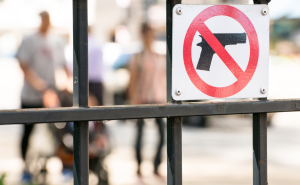Questions and Answers on U.S. v. Rahimi, the Major Gun Case Before the Supreme Court During its 2023–2024 Term

On June 21, 2024 the Supreme Court ruled to uphold the existing law prohibiting firearm possession for those subject to domestic violence protection orders. A full update to this article is forthcoming.
This article was updated November 10, 2023 to reflect new developments since the first version posted October 10, 2023.
Kelly Roskam, JD, is the director of law and policy at the Johns Hopkins Center for Gun Violence Solutions. Here, Roskam answers frequently asked questions about U.S. v. Rahimi, the major gun case before the Supreme Court during its 2023–2024 term. The Court heard the case on November 7.
What is the U.S. v. Rahimi case about? What will the Supreme Court decide in U.S. v. Rahimi?
The Supreme Court will decide if a federal law prohibiting possession of firearms by people subject to domestic violence protection orders is Constitutional—in other words, if an abuser who has a protection order or restraining order against them can legally keep their guns. The stakes are high. If the Supreme Court overturns this law, it would likely increase domestic gun violence and put lives—especially the lives of women—at risk.
The current law, in effect for almost 30 years, protects abuse victims and survivors by prohibiting people subject to domestic violence restraining orders from possessing firearms. It was routinely upheld as Constitutional, until a 2022 Supreme Court case, New York Rifle and Pistol Association, Inc. v. Bruen, placed all previously settled gun laws in jeopardy by significantly changing the way courts must evaluate Second Amendment cases. The 5th Circuit Court of Appeals—which covers Texas, Mississippi, and Louisiana—heard the Rahimi case and overturned the existing federal law in those states. The Supreme Court will review the 5th Circuit’s Rahimi decision during its upcoming 2023-2024 term.
Listen to The Podcast
You mentioned the major gun case during the last Supreme Court session was NYSRPA v. Bruen. How does the Bruen decision affect U.S. v. Rahimi?
In 2022, the Bruen decision dramatically changed how courts can rule on Second Amendment cases. Before Bruen, lower courts evaluated gun laws using a combination of historical research and how well-tailored the laws were in achieving an important government interest such as public safety. However, in the Bruen case, the Supreme Court limited the analysis to how closely the modern day law follows our nation’s historical tradition of firearm regulation. Public safety can only be considered for gun violence if comparable historical laws did so as well.
Because all other courts must rely on the Supreme Court’s guidance when interpreting our nation’s gun laws, a host of new challenges to long-established gun laws have emerged. The Supreme Court’s lack of clarity regarding precisely how to compare modern-day laws to the historical record has placed every gun law on uncertain ground. Courts, legislators, and legal scholars have expressed confusion about how similar modern laws must be compared to laws in and around the founding era in the late 1700s. How should a judge evaluate modern laws that protect women from abusers when our nation’s founding era laws were crafted when women weren’t even allowed to vote? So far, courts have been divided on how to apply this new test, some striking down and others upholding the same law using the same historical record. Moreover, I’ve argued that if this new framework is interpreted to forbid consideration of public safety, it will lead to real-world consequences: more gun access by dangerous people and more gun deaths caused by them.
How will Rahimi impact our current gun laws? Why is U.S. v. Rahimi important?
Though we cannot know for certain until a decision has been issued by the Supreme Court, there are two significant possible impacts I would like to highlight.
First, validating the federal law prohibiting persons subject to domestic violence protective orders from gun possession will literally mean the difference between life or death for many victims of abuse, their family, friends, law enforcement, and the broader community.
Second, U.S. v. Rahimi provides the Supreme Court with an opportunity to clarify how lower courts should apply the new framework laid out in Bruen. This will significantly impact the continued viability of current gun laws and the ability of legislators to effectively address the ongoing gun violence epidemic.
What are the links between domestic violence and guns?
Over 12 million U.S. adults are the victims of domestic abuse annually. Research shows that armed domestic abusers pose a significant risk to their intimate partners, families, friends, law enforcement, and the general public. One study found that an abused woman is five times more likely to be killed by a male partner when there is a firearm in the house. Research also found that the most common additional victims of domestic violence were the victim’s children, current partner, and friends or roommates. Another study found that between 1996 and 2010, 95 percent of law enforcement officers who were killed while responding to domestic-violence calls were killed with firearms. Additional research found that in 68 percent of mass shootings between 2014 and 2019 the shooter either had killed an intimate partner or other family member or had a history of domestic violence. Allowing domestic abusers to retain access to their guns puts so many people at risk.
Is the law under consideration in Rahimi even necessary? Aren’t abusers disarmed by other laws or through other means?
The law at issue in Rahimi is essential. Domestic violence protective orders that prohibit firearm possession are a vital tool to protect victims and survivors. Though persons convicted of felony or misdemeanor crimes of domestic violence are also prohibited from possessing firearms, reliance on the criminal justice system alone is insufficient. Many abusers are not convicted of felony or misdemeanor crimes of domestic violence and without protective orders, they would be able to keep their guns. Additionally, there are numerous legitimate reasons why an individual may not want their abuser convicted of a crime, such as loss of financial support, acute risks of physical and psychological danger from testifying against their abuser in court, potential separation from children and housing, and more.
You recently co-authored an amicus brief in the U.S. v. Rahimi case. What is an amicus brief and what did you argue?
An amicus brief is a chance for experts who are not party to the case to offer insights and arguments to aid the Supreme Court’s decision making when they rule on cases. They’re often written by organizations or individuals with specific expertise in matters before the court – in our case, public health researchers and lawyers focused on ending the epidemic of gun violence. Supreme Court Justices often cite amicus briefs in their opinions.
In the amicus we argue that federal law prohibiting firearm possession by persons subject to domestic violence protective orders is Constitutional because it continues our nation’s historical tradition of disarming persons deemed to pose a danger to society and others. We use a wealth of public health research to illustrate just how dangerous domestic abusers are, specifically with access to guns, and tie it back to historical laws that similarly limited firearm possession by people perceived to pose a risk of danger to others.
The U.S. has a longstanding tradition of disarming individuals who present particular dangers. Historical “going armed” laws removed firearms from individuals who publicly carried firearms in a threatening manner, while surety laws required individuals who were potentially dangerous to post bonds. The history of firearms regulation in the U.S. demonstrates a willingness to limit access to individuals who are deemed dangerous to the public.
Congress enacted the law at the center of Rahimi to address gun violence by domestic abusers who have been found dangerous, but who have not been convicted of a domestic violence crime. The law ensures that intimate partners who have been subject to abuse are protected from the continued threat of gun violence. We explain that the statute is a historically rooted tool that serves to prevent domestic abuse from escalating into lethal violence.
The Supreme Court heard oral arguments in U.S. v. Rahimi on November 7, 2023. What can you tell us about the arguments?
It remains to be seen if the Court takes this opportunity to significantly clarify how lower courts should apply the Bruen framework, but in the oral arguments it appeared to largely agree that courts evaluating Second Amendment challenges should look at the nation’s historical tradition of firearm regulations more broadly than the 5th Circuit did in United States v. Rahimi. The Court also appeared to agree that there is a historical tradition of disarming dangerous persons and that domestic abusers are dangerous. Though we predict that there is enough support to broadly uphold the law, it is possible the court may leave room for challenges to specific applications of the law in later cases.
When will the Supreme Court hear arguments and decide the U.S. v. Rahimi case?
Oral argument in U.S. v. Rahimi was held on Tuesday, November 7, 2023, and a decision is likely to be issued in June or July 2024.




